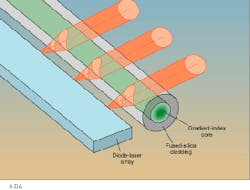Compact and economical diode lasers are the sources of choice for a wide variety of applications. However, they do have the drawback of beam astigmatism, which must be corrected in many cases. Rotationally symmetric lenses of high numerical aperture and quality, such as microscope objectives, can be used to collimate the beam, correcting both the fast axes and slow axes simultaneously. Because the sagittal numerical aperture of the diode laser is usually a few times smaller than the tangential one, such solutions are often more complex, expensive, and space intensive than required. Single glass aspheres provide a simpler method for this correction, but for many applications a more practical approach is that of cylindrical microlenses.
Cylindrical microlenses
One method of cylindrical-microlens fabrication involves fiber drawing. The simplest microlens that can be made using this process is a homogeneous silica fiber. Such cylindrical lenses are useful in applications involving small numerical apertures. Because of excessive aberrations, these cylindrical microlenses have limited use in high-numerical-aperture applications.
To make fiber-type cylindrical microlenses suitable for higher numerical apertures, one side of a fiber preform is ground to a hyperbolic shape while the other side is either planar or curved. The preform is then drawn, producing fiber with the same shape but scaled to a smaller size.
The advantage of this method is that expensive polishing processes are replaced with the fire-polishing that occurs during the fiber drawing. In this way, very-short-focal-length cylindrical microlenses with good performance at high numerical apertures are produced. Lenses with this design tend to be difficult to align due to the hyperbolic surface. For any point of the light source that is not strictly in the focal point or on the focal line of the lens, good collimation properties of the hyperbola are lost.
Gradient-index microlenses
Lenses of simple geometry such as ball lenses and rod cylindrical lenses seem to be the best candidates for mass production. They are often used in coupling applications when the numerical apertures involved are moderate. Both types, however, suffer from huge spherical aberrations at higher apertures. An efficient way to preserve the simple cylindrical shape and eliminate the aberrations is to use gradient-index optics.
In designing such optics, the problem was not finding the refractive-index profile that would correct the aberration, but finding a refractive-index distribution that could be manufactured in volume at low cost. The patent-pending solution developed at the National Optics Institute (NOI, Quebec City, Canada) is based on a gradient-index core with a homogeneous cladding (see figure). This approach is perfectly suited for fiber-preform modified chemical-vapor-deposition (CVD) technology because the glass tube that is the starting point in the process of making the fiber preform is incorporated into the design
Using modified CVD, various layers are deposited inside the tube to give the necessary refractive-index distribution. When the tube is collapsed, the preform itself becomes a good cylindrical lens with a diameter of about 9 mm. If used in its original form, the preform would be a very expensive cylindrical macrolens. However, fiber lenses drawn from the preform can be produced at reasonable cost.
With a wavelength design of 670 nm and a radius R, the lenses have an effective focal length of 1.37R, a back focal length of 0.37R, and a numerical aperture of 0.5. Diameters of finished lenses range from 60 µm to 3 mm, with variable length; typical lenses are 300 µm in diameter and 10 cm in length.
Performance
The 8.3-mm-diameter optical-fiber preform interferometrically tested at 633 nm showed a 1/l wavefront deviation in double-pass mode. Normally, when the fiber is drawn the aberrations scale accordingly, and we can therefore assume that the microlenses are diffraction-limited.
The light intensity distribution produced by the diode laser and the collimating lens was measured at 800 mm with an 8.5 by 6.4-mm CCD array. The gradient-index microlens showed good performance when tested with an LCW 100 diode-laser array from Laser Diode (Edison, NJ). Alignment was straightforward, and the far-field divergence angle containing 95% of the light was 0.35°.
Because the cladding is made of fused silica, these lenses can easily survive exposure to high temperature. For example, F2, the glass often used to make microlenses, has a transformation temperature, Tg, of 438°C, while for the fused silica Tg is closer to 1100°C.
Applications
The main use of cylindrical microlenses is in correcting astigmatism of diode lasers and diode-laser arrays. The gradient-index microlens was used in a diode-laser-array illuminator built by NOI. This application required that the output of a 32 by 32-element diode-laser array be collimated to within 2°. The array consisted of two side stacks of 32 bars, each having 16 emitters. The individual emitters had a total area of 105 by 1 µm. The fast axis of the array was collimated with gradient-index microlenses, while the slower axis was collimated by homogeneous cylindrical lenses.
The cylindrical gradient-index fiber lens provided higher transmission and smaller beam divergence than homogeneous cylindrical microlenses or hyperbolic-shaped lenses. Apart from optical quality, it appears that the best property of the gradient-index microlens is easy alignment. This is a very important for collimating diode-laser bars or arrays that are often not perfectly aligned themselves. The gradient-index microlens showed superior performance when tested.
Sead Doric | CEO, Doric Lenses
Sead Doric, Ph.D., is CEO of Doric Lenses (Québec City, QC, Canada).
